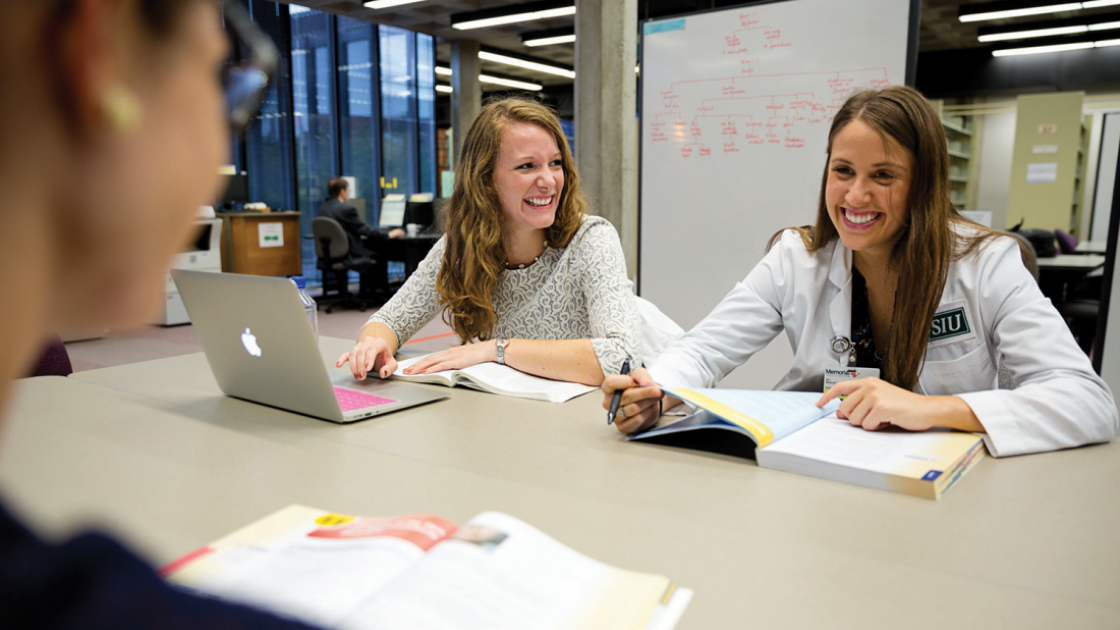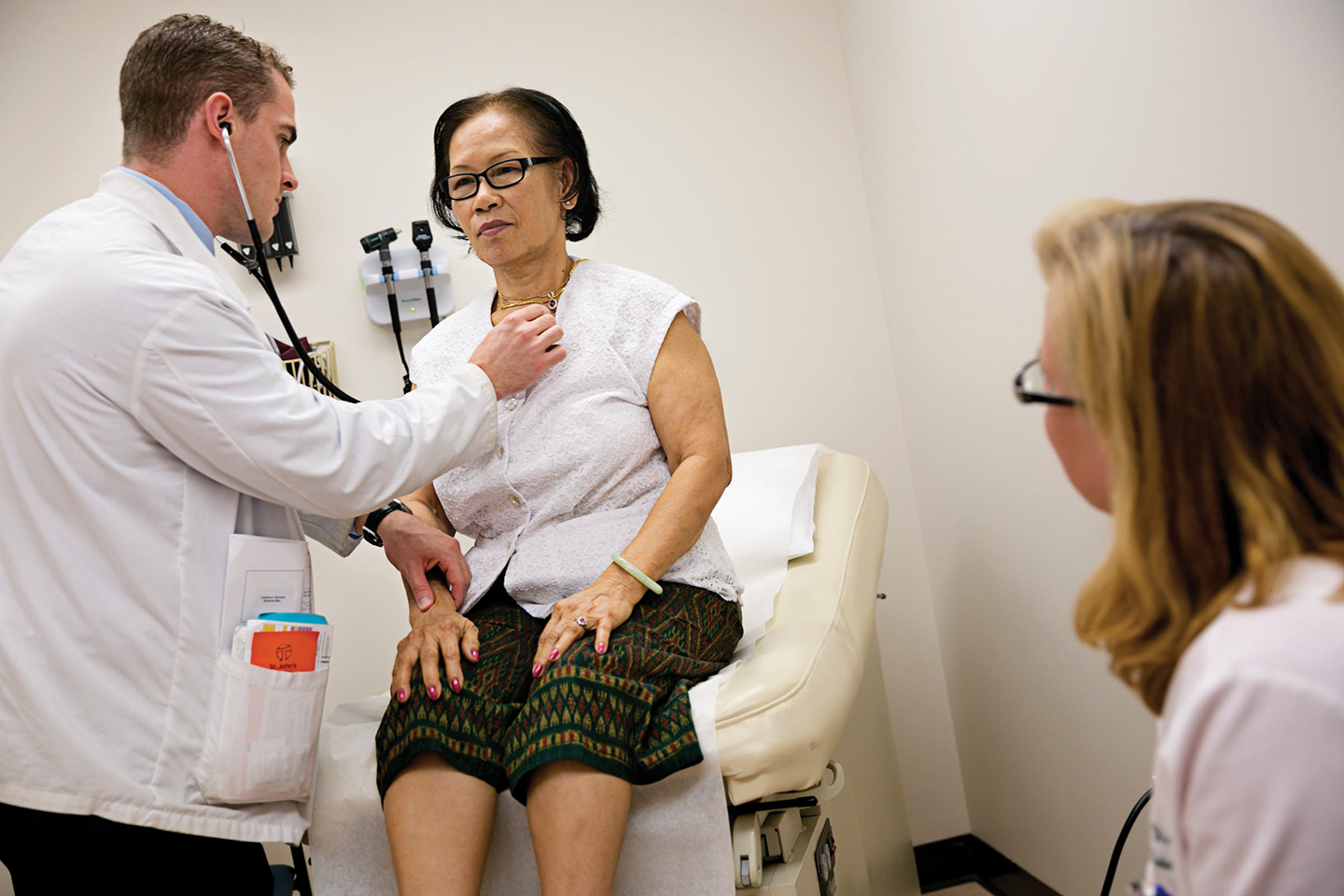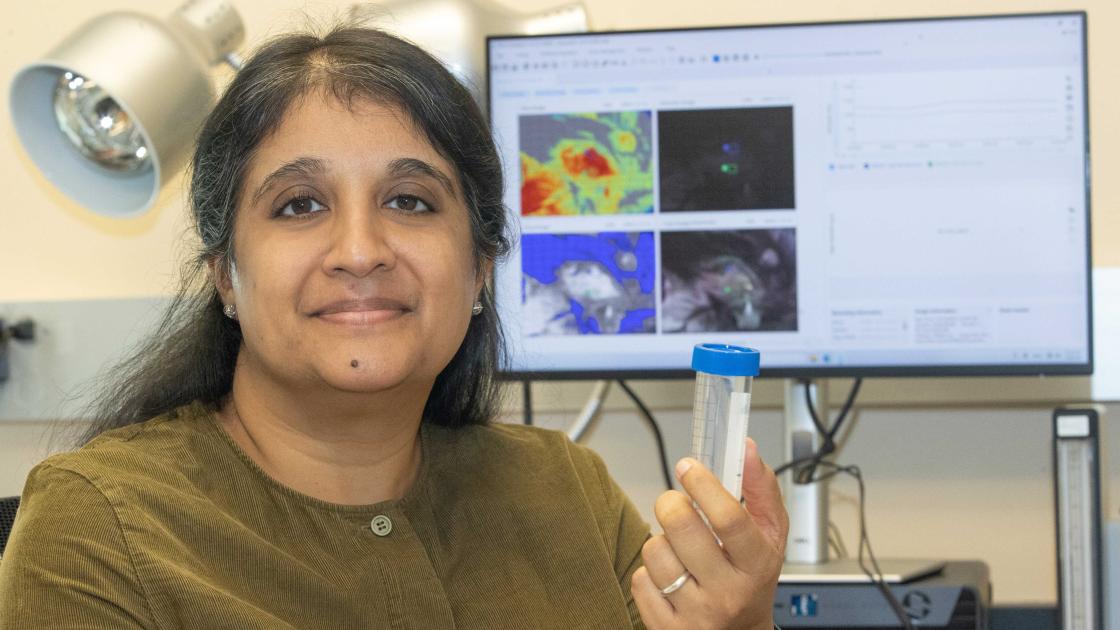
Deliberate Practice
SIU’s medical student curriculum to get first major reform since 2000
Written by Karen Carlson | Photographs by Jason Johnson
Published in Aspects Magazine, Autumn 2014 (37-4)
Karen Bertels remembers the most memorable moment of her third year — assisting in the delivery of a baby during her OB rotation. “It was an amazing moment to be part of a new life,” she says.
An amazing moment, but Bertels doesn’t plan to become an obstetrician.
She fondly remembers the clerkships that she completed last spring. “I liked them, but I spent weeks on rotations I had no interest in. But I loved both pediatrics and emergency medicine. I wish I had time to go back to both and learn more about them.”
To those on the outside, the third year may look like a well-oiled machine: after two years of problem-based learning, standardized patient exams and lectures, the third year is a fast-paced plunge of clinical clerkships in six of the specialties where students get into the trenches of daily clinical care. “At the end of second year, medical students are very good at reading and repeating,” says fourth-year medical student Andrew Mitchelson. “The field of medicine, though, requires that we apply that knowledge to patient care. The third year is when the loose ends start to get pulled together.” 
Those loose ends start to come together in a flurry of a few hours in a clinic, a lecture or two and a lot of personal time anxiously studying for exams (called shelf exams) that loom at the end of every unit. Direct clinical experiences are random. “You only get a few weeks, or maybe less, working in each field,” Mitchelson says. “Once you find a few areas that you enjoy, there is not time to revisit them until fourth year. Also, because of these short time frames, it seems difficult for faculty to get to know us and accurately assess our knowledge.”
Although the SIU clerkships are some of the highest rated by students, studies have found that they do little to improve clinical reasoning skills. “We presumed that the students’ clinical skills gradually improved each year, including third year,” says Associate Dean for Education and Curriculum Debra Klamen, MD, MHPE, professor and chair of medical education. “We were wrong, and something has to be done.” SIU studies by Dr. Klamen and Reed Williams, PhD, discovered that clinical reasoning plateaued in the third year. Clinical reasoning skills are how physicians collect, process and understand information to make decisions for their patients.
Harald Lausen, DO, is the family medicine clerkship director. “We’ve been thinking about this since 2009. Our studies have found that the clinical skills and reasoning gained in Year Three is flat.”
Dr. Klamen, Dr. Williams, Dr. Lausen and a team of SIU School of Medicine faculty have been working since that time to improve clinical knowledge in Year Three. In May, the Department of Medical Education received a grant from the Macy Foundation totaling $577,000 to revamp the Year 3 curriculum and improve clinical reasoning overall. Set to be implemented in 2016, it will be the first major reform to the SIU School of Medicine curriculum since 2000. “This innovation is a refreshing break from the traditional medical school curriculum and addresses interests Macy has in competency assessment, critical thinking and individualization of the educational trajectory,” said Yasmine R. Legendre, program associate at the Josiah Macy Jr. Foundation.
The grant will allow work to continue with even more muster. Five working groups are looking at everything from the logistics of immersive experiences and individual experiences, student and program assessment and faculty development. “This is a huge change and requires a careful approach,” says Tracy Lower, MD, a pediatrician who
co-chairs the oversight committee.
SIU medical educators Heeyoung Han, PhD, and Nicole Roberts, PhD, studied what students do in the third year and found that they socialized into medicine and “found their people” — that is, decided what specialty they wanted to pursue.
“Third year is the year we’ve been waiting for,” says medical student Ashley Satorius, who is currently doing her clerkship rotations. She and other medical students have been involved on every committee making the decisions. “I want to gain a broad overview of the core fields in medicine: how to take care of adults, children, pregnancy and everything in between,” Satorius says. “I’m excited to gain patient interview skills and learn how to develop and select a differential diagnosis while I’m talking with them, then knowing what physical exams to perform, labs/imaging to run and most importantly how to treat the person. And I want to decide how I want to spend the next 40 years and how I want to shape my future career.”
Y3 Transformation Project
Although students are assigned to full 8-hour days in the SIU HealthCare clinics, research here showed that on average, students only spent 3½ hours a day getting front-line experience with patients; the rest of their day is spent studying for tests, attending lectures and observing on the sidelines. Replicated studies at other institutions confirmed that students at other medical schools have the same experiences. “The purpose of the third year is to help students understand and become comfortable with the clinical environment and be involved in lots of clinical care,” Dr. Lausen says. “They aren’t going to achieve that as well with just three hours a day.”
As chairperson of the Year Four curriculum, Dr. Lower says students come into the fourth year well prepared but acknowledges that the time Y3 students spend doing direct patient care is low. “Tests take a higher priority,” she says. Students eye Step 2 of the National Board Exam during the fourth year as a beast that must be conquered.
In the reformed curriculum, students entering the third year will not only be better prepared in their clinical reasoning, but also will have a have a richer experience interacting with patients.
To improve clinical reasoning, an online and video-based curriculum will teach students the Critical Clinical Competencies (aka the “Triple Cs”), learned gradually over the first three years. The CCC encompasses 144 discrete diagnoses. “We will be able to guarantee that students see all these cases and reason their way through to a competent level,” Dr. Klamen says. The Macy Grant will partly fund the development of an electronic platform and video modules with standardized patients to help accomplish this.
A team of faculty, staff and students, the Y3 Innovations Group, are paving new paths to enrich the third-year experience.
The proposed revisions change the structure of the clerkships from seven rotations of varying length (anywhere from 4-10 weeks) to four-week stints in eight clinical disciplines from July to February. The goal is to give students more quality time in direct, supervised patient care.
Dr. Klamen says that the students will have the same or more hours in most disciplines and a longer duration in the clinics, which equals better quality. “Instead of six weeks of working three hours a day, students will spend four weeks working six or seven hours a day.” The quality of time in the clinics is key to socializing students into medicine and helping them decide on their future career paths, Dr. Klamen says.
Other revisions to help maximize valuable time in clinics: No lectures except a few select ‘need to know’ online videos, no shelf exams that drive students out of the clinics to study, and mentors to guide students along the entire year be helping to sharpen skills, select a residency and apply.
Mentoring will improve with the revised third year. Dr. Klamen notes that now, students are paired with several different faculty. “Some faculty needed photos to remind them of students to give evaluations,” she says. By 2016, each student will be paired with few attending physicians instead of shadowing a different physician every day. “This allows time to build a relationship of trust and teaching,” Dr. Lausen says, though he notes it will be challenging for some departments to find enough faculty for each student. He is a co-chair of the Triple C committee.
He likens it to the preceptor model, where medical students work with one family medicine physician at a time. “We need continuity with a mentor versus the disruption of meeting several physicians over the student’s clerkship. Mentors could give daily feedback and monitor progression.”
From March through June, third-year students will plunge into what’s affectionately named the “Deep Dive.” Here is where they really focus on the one discipline that has “their people.” Students will spend these four months working daily with their chosen specialty and refining their clinical skills.
Susan Hingle, MD, professor, interim chair of internal medicine and internal medicine clerkship director, sees great potential in the Deep Dive. She sees the Deep Dive as a way to engage more faculty in the educational processes. As a new faculty in 1998, she became passionate about medical education by becoming involved in SIU’s curricular change, titled Curriculum 2000. But fully developing faculty as teachers will be imperative to the success of the new initiatives, she says.
Change is good; change is hard
Dr. Klamen notes that this change is innovative and unusual — no other medical school is pursuing this kind of third year. While SIU faculty are largely supportive, many have raised concerns. Some worry that there aren’t enough clinical faculty to give each student one-on-one mentoring for four weeks. Others say that the longer clerkships provide broad patient exposure, self-directed learning, team-based care experiences and lessons in the complex medical system. With only four weeks, students may not develop important patient relationships, which are core to many physicians.
Faculty say that numerous innovations have been implemented in the third year — albeit on a smaller scale: medical humanities courses, patient safety modules and humanism in medicine courses. Some faculty worry that these may be lost in the third year.
“We have to decide what the goal of the four-week clerkship will be,” Dr. Hingle says. “It’s not just figuring out what you want to do. We’re doing foundational building of medical knowledge, medical systems, not just disciplinary knowledge.”
She points out that students learn other valuable skills during their clerkships. “Our health care system is so complex — there are so many other things they’re learning about; maybe it’s unreasonable to think clinical reasoning skills would significantly improve, at least in the ways that have been measured. They’re learning how hospitals and clinics work, the business side of medicine, how to communicate as a medical professional, how to work in a dynamic clinical care team and how to handle the pressures of medicine and grow as a professional.”
Bertels, a member of the Year 4 committee, worries about the disappearance of the shelf exams, taken at the end of each clerkship. “The shelf exams are great preparation for Step 2. Shelf exams drive us to work hard and perform well during clerkship,” she says. “If you don’t have an exam during your study, you need willpower to prepare for Step 2.” Step 2 is the second part to the licensure exam, which tests students’ ability to apply medical knowledge to patient care.
Dr. Lausen, a co-chair of the oversight committee, explains that shelf tests will be available to students who need it before the Deep Dive. “They could choose a specialty specific exam, a practice exam or remediation on clinical skills. We need flexibility, and it will be learner-directed to best prepare them for Step 2.”
Subcommittees are addressing student assessment, faculty development and program evaluation.
With many questions yet to be answered, the Y3 committee has much work to do before this year’s entering class marches into its third year in 2016. The Macy Grant is a national confirmation that Year 3 needs attention. Students and faculty are taking a careful approach to ensure that the new Year 3 keeps SIU students prepared and competitive for the best residencies.
“The key to becoming an expert is deliberate practice,” Klamen says, quoting a five-part educational model by Swedish psychologist and Conradi Eminent Scholar and Professor of Psychology Anders Ericcson: 1) developing long-term relationships; 2) understanding strengths and weaknesses and setting goals and expectations; 3) observation; 4) getting practice; and 5 getting immediate feedback. Ericcson is known for citing the “10,000 hour” rule to become an expert.
“The greatest improvement in the curriculum will come from the amount of time that the new curriculum allows each student to spend with faculty,” says Mitchelson. “The ability to further explore fields of interest prior to fourth year will be another real advantage for students.”
Bertels says it’s important that students still get exposed to everything — she was very surprised for example, by how much she unexpectedly liked in-patient psychiatry –– but she likes the idea of more time with specialties. “I think changes to the calendar year will be beneficial to students’ career choices. We will have more autonomy in our education.”
Although some faculty have concerns, SIU has always been a trailblazer in medical education. Dr. Lower, who trained in the early ’80s under the then-new problem-based curriculum, remembers deflecting doubtful residency interviewers who questioned the ground-breaking, yet unproven PBL curriculum. Thirty years later, PBL is the standard in medical education worldwide.
“Change is good,” Dr. Lower says. “Students need to learn how to learn, to develop continuous, quality improvement for life. A more student-centered curriculum encourages that.”
“The goal of the new curriculum is innovation at its best,” says Satorius. “The world of health care is changing, and it’s important to keep up with that change at all levels, including medical education. The new third year will develop clinical skills in students and boost the preparation for residency so that SIU graduates will be the leaders in their residency programs. With every change there is potential for a short period of hardship; however, it is the innovation that will drive success.”



